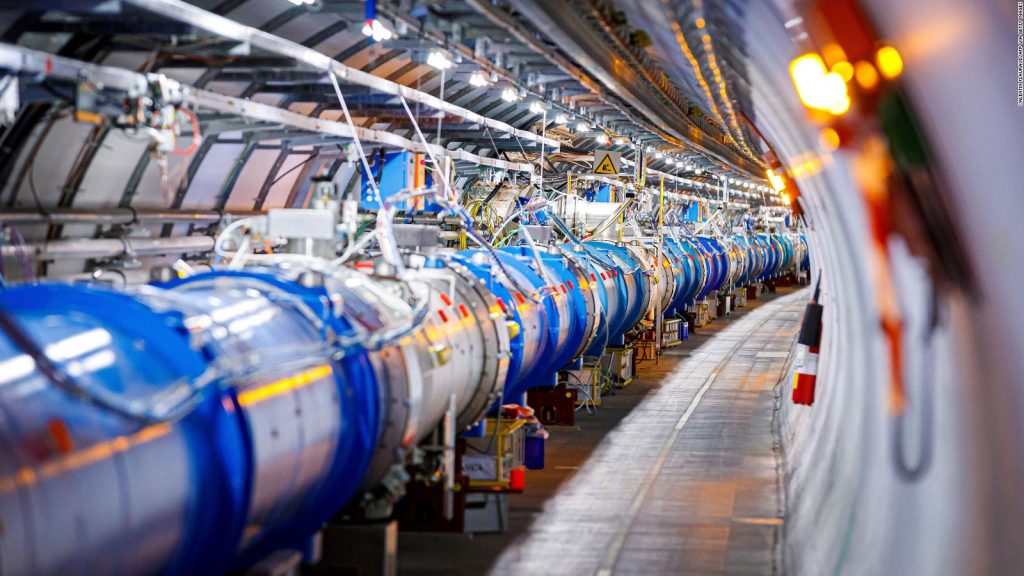(CNN) – A decade ago, the European Organization for Nuclear Research’s (CERN) Large Hadron Collider, the most powerful particle accelerator on Earth, confirmed the existence of a subatomic particle called the Higgs boson, which is the cornerstone of the universe. can be tracked. Back to the “Big Bang” billions of years ago.
Now physicists at CERN on the Swiss-French border will restart the collider in an effort to understand more about the Higgs boson and other subatomic particles and the mysteries of dark matter, an elusive and invisible substance that cannot be seen. or reflects or emits light.
The Large Hadron Collider is a ring 27 kilometers in circumference located deep in the Alps. It consists of superconducting magnets cooled to -271.3 degrees Celsius, a temperature lower than that of outer space. The collider smashes small particles together to allow scientists to observe and analyze what’s inside.
Proton beams began circling through the accelerator complex in April, when it was turned on after being shut down for three years for maintenance and modernization.
This Tuesday, scientists at CERN Start collecting data For its experiments, the Large Hadron Collider will operate 24 hours a day for about four years. This is the third time the massive machine has been commissioned, with greater accuracy and detection potential than ever before thanks to updated reading and selection systems, as well as new detection systems and computing infrastructure.
“When we do we expect to find something unexpected, a surprise. That would be the best outcome. But of course the answer is in the hands of nature, and that depends on how nature answers the open questions in fundamental physics,” Fabiola said. Gianotti, CERN’s general manager, in a video posted on its website.
“We are looking for answers to questions about dark matter, why the Higgs boson is so light, and many other open questions.”
Understanding the Higgs boson
Physicists François Englert and Peter Higgs first theorized the existence of the Higgs boson in the 1960s, and the Standard Model of Physics lays the foundation for how elementary particles and forces interact in the universe. However, the theory fails to explain how particles actually gain their mass. Particles, or parts of matter, vary in size and can be larger or smaller than atoms. Electrons, protons, and neutrons, for example, are the subatomic particles that make up the atom. Scientists now believe that the Higgs boson is the particle that gives mass to all matter.
In 2013, a year after the particle was discovered, Englert and Higgs won the Nobel Prize for their optical prediction. But there is still a lot that is unknown about the Higgs boson, and revealing its secrets could help scientists understand the universe at its smallest scale and some of the universe’s greatest mysteries.
Opened in 2008, the Large Hadron Collider is the only place in the world where the Higgs boson can be produced and studied in detail. The third test Successfully launched It’s 10:47 a.m. ET on Tuesday.
In the final round of experiments, CERN scientists will study the properties of matter under extreme conditions of temperature and density, as well as search for explanations for dark matter and other new phenomena, either through direct searches or indirectly, through precise measurements of properties from known particles. .
“Although all the results obtained so far are consistent with the Standard Model, there is still plenty of room for new phenomena beyond what this theory predicts,” said Michelangelo Mangano, a theorist at CERN. In a press release.
Dark matter is believed to make up most of the matter in the universe and has been previously discovered for its ability to cause gravitational distortions in outer space.
Luca Malgrei, a spokesperson for CMS (Compact muon solenoid), said one of the Big Four experiments at the Large Hadron Collider, built around a massive electromagnet.
Sarah Spary and Nick Thompson contributed to the report.

“Music buff. Social media lover. Web specialist. Analyst. Organizer. Travel trailblazer.”

:quality(85)/cloudfront-us-east-1.images.arcpublishing.com/infobae/TEQF6EONZRFGLLLDIDD4L2O4EE.jpg)

:quality(75)/cloudfront-us-east-1.images.arcpublishing.com/elcomercio/XU32LRAEZFDDPNVHLFU3CKVBYY.jpg)



More Stories
Sheinbaum, Galvez, Mainz campaign wrap-up, news and more
Sheinbaum and Mainz’s CDMX campaign wraps up: Road Alternatives and Street Closures
Ortega attacks Humberto Ortega and declares him a “traitor to the country”